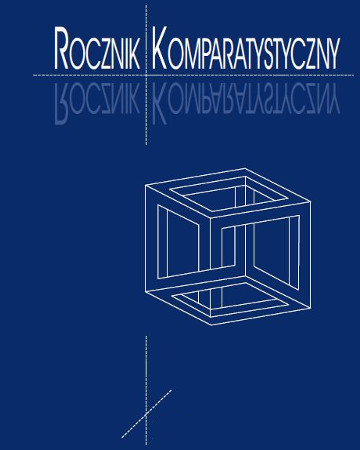





| Autorzy: |
Esther
Makwin Ephraim

Uniwersytet Humanistyczno-Przyrodniczy im. Jana Długosza w Częstochowie |
| Słowa kluczowe: | toposy kulturowe religia przesąd Chinua Achebe Czesław Miłosz |
| Data publikacji całości: | 2021 |
| Liczba stron: | 15 (293-307) |
CytowanieEphraim, Esther Makwin. „The Uniting Cultural Topoi In Chinua Achebe’s Things Fall Apartand Czeslaw Milosz’s The Issa Valley”. Rocznik Komparatystyczny 12 (2021): 293–307.DOI: 10.18276/rk.2021.12-13.
| 1. | Achebe, Chinua. Things Fall Apart. London: William Heimann Ltd, 1958. |
| 2. | Atran, Scott, Norenzayan Ara. “Religion’s Evolutionary Landscape: Counterintuition, Commitment, Compassion, Communion.” Behavioral and Brain Sciences (2004): 713–770. https://www2.psych.ubc.ca/~ara/Manuscripts/AtranNorenzayan BBS.pdf. |
| 3. | Baronas, Darius, S.C. Rowell. The Conversation of Lithuania from Pagan’s Barbarians to Late Medieval Christians. Vilnus, Lithuania: Institute of Lithuanian Literature and Folklore, 2015. |
| 4. | Barth, Christiane. “In illo tempore, at the Center of the World: Mircea Eliade and Religious Studies’ Concepts of Sacred Time and Space.” Historical Social Research 38.3 (2013): 59–75. |
| 5. | Benedict, Ruth. Patterns of Culture. Boston: Houghton Mifflin Company, 1934. |
| 6. | Drehe, Iovan. “The Aristotelian Dialectical Topos.” 2011. Argumentum 9.2 (2011): 129–139. www.semanticscholar.org/paper/The-Aristotelian-Dialectical-Topos-Drehe/f980a5641fb4b0c67968012ee2f343bbbe6cd08f [accessed 28.09.2020]. |
| 7. | Eliade, Mircea. Patterns in Comparative Religion. London–New York: Sheed & Ward, 1958. |
| 8. | Godchecker. The Lithuanian Mythology: The Lithuanian Panteon. https://www.godchecker.com/lithuanian-mythology/pantheon/ [accessed 10.12.2021]. |
| 9. | Hunter, Lynette. Toward A Definition of Topos: Approaches to Analogical Reasoning. London: Macmillan Education, 1991. |
| 10. | Lewis, Richard D. When Cultures Collide: Leading across Cultures. Finland: Nicholas Brealey Publishing, 2006. |
| 11. | Mason, Otis Tufton. “Similarities in Culture.” The American Anthropologist 8.2 (1895): 101–117. https://anthrosource.onlinelibrary.wiley.com/doi/epdf/10.1525/aa.1895.8.2.02a00000. |
| 12. | Milosz, Czeslaw. The Issa Valley. United States of America: Farrar, Straus and Giroux, 1978. |
| 13. | Narbutt, Theodor. Dzieje starożytne narodu litewskiego [History of the Lithuanian Nation]. Vols 8–9. Vilnius: A. Marcinowski, 1835. |
| 14. | Nduka, Udeagha, Grace Ozioma Nwamah. “Chinua Achebe’s Things Fall Apart and the Role of Women in Igbo Traditional Religious Culture.” Open Journal of Social Sciences 7.12 (2019): 272–289. https://www.scirp.org/journal/paperinformation.aspx?paperid=97257 [accessed 21.05.2021]. |
| 15. | Olsson, Tord. Frejya-The Great Goddess of the North: Lund Studies in History of Religions. Lund: Department of History, University of Lund, 1994. |
| 16. | Parrinder, Edward Geoffrey. African Traditional Religion. London: Sheldin Press, 1976. |
| 17. | Rapp, Christoph. “Aristotle’s Rhetoric.” 1.02.2010. Stanford Encyclopedia of Philosophy. https://edisciplinas.usp.br/pluginfile.php/5585434/mod_resource/content/1/04Aristotles%20Rethoric.pdf [accessed 26.05.2021]. |
| 18. | “Religion.” Dictionary Merriam Webster. https://www.merriam-webster.com/dictionary/religion [accessed 31.05.2021]. |
| 19. | Rosenblatt, Daniel. “Anthropology Made Safe for Culture: Patterns of Practice and the Politics of Difference in Ruth Benedict.” American Anthropologist 106.3 (2004): 459–472. |
| 20. | Tallich, Paul, Kimball C. Robert. Theology of Culture. New York: Oxford, 1959. |
| 21. | Taylor, Edward B. Primitive Culture: Researches into the Development of Mythology, Philosophy, Religion, Art, and Custom. Cambridge: Cambridge University Press, 2012. |
| 22. | The Nature of Religion. LibreTexts. https://socialsci.libretexts.org/Bookshelves/Sociology/Introduction_to_Sociology/Book%3A_Sociology_(Boundless)/14%3A_Religion/14.01%3A_The_Nature_of_Religion/14.1A%3A_The_Nature_of_Religion#:~:text=For%20ex [accessed 20.05.2021]. |
| 23. | Tien, Pham Huu. “The Similarity Between Cultures in the World Today.” Eurasia Review News & Analysis (14.05.2017). Open Edition. https://www.eurasiareview.com/14052017-the-similarity-between-cultures-in-the-world-today-oped/ [accessed 15.10.2021]. |
| 24. | Wallis, W.D. “Similarities in Culture.” American Anthropologist. New Series 19.1 (1917): 41–54. https://anthrosource.onlinelibrary.wiley.com/doi/pdfdirect/10.1525/aa.1917.19.1.02a00080. |